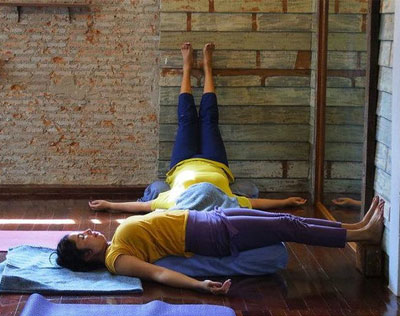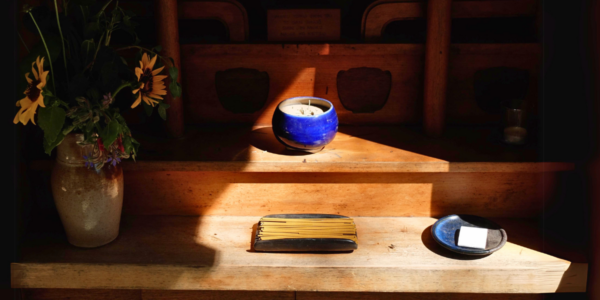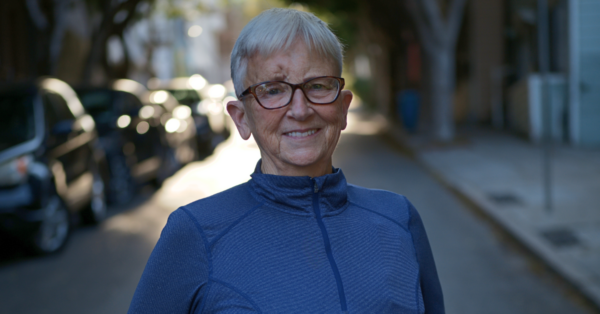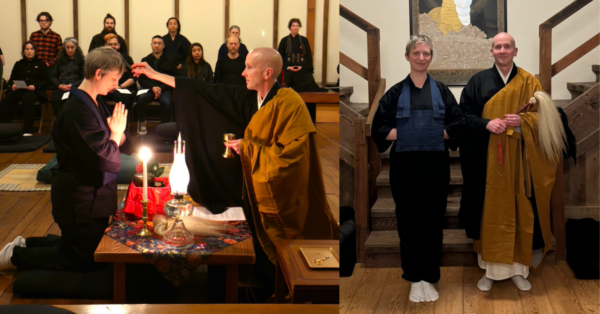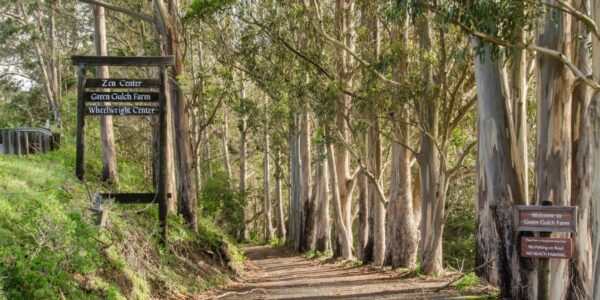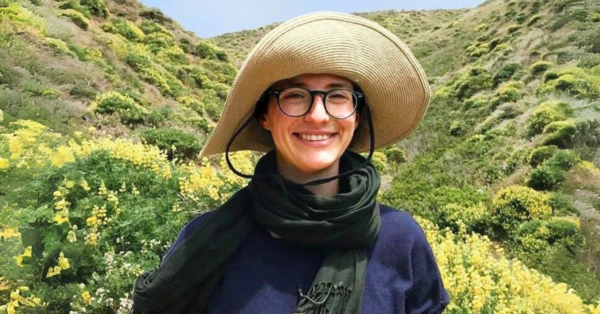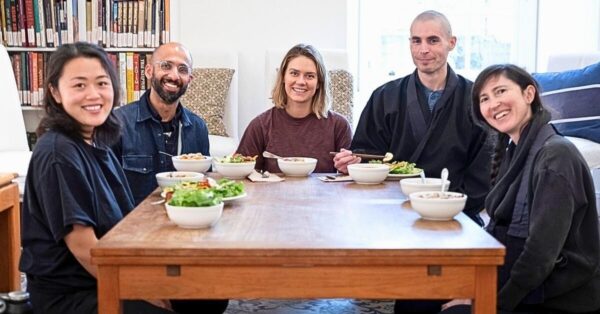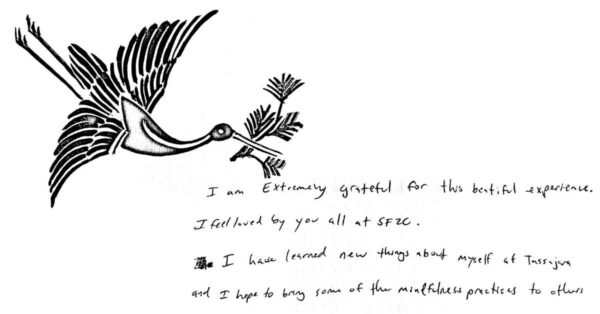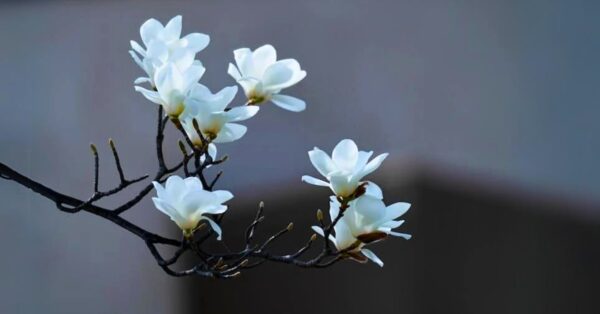Living Each Moment for the Benefit of All Beings
Samantha Ostergaard, who has been teaching yoga in the Iyengar tradition for eight years, and specializes in yoga therapy for back care in private yoga therapy sessions, will join her husband, SFZC President and long-time yoga student Do-On Robert Thomas in a long-weekend study of yoga, Zen, and the Bodhisattva. Their retreat will explore “the Bodhisattva’s practice of turning each moment of our life into a moment of acceptance, compassion, and awakened activity that benefits ourselves and others.”
Both Robert and Samantha have contributed their thoughts on the union of these practices, which appear below.
“Yoga is such a powerful way to make the experience of sitting in meditation posture very comfortable and easy, even for people who have always had a very difficult time with it, because of pain in their legs or in their backs. Yoga is so powerful that, in just a few yoga sessions, this chronic pain will frequently go away completely. It has happened often that one of the participants has said at the beginning of one of these retreats that she has never been able to enjoy the experience of meditation because physically it had always been painful, and so her meditation has only been about dealing with the pain of the physical position. Some of these people have been practicing meditation in spite of the pain, while others have been prevented from meditating by the pain. Sometimes after just one session of yoga followed by meditation, or sometimes by the end of the retreat, these people have told me that they have for the first time in their lives enjoyed the peacefulness of meditation, because after the yoga sessions the physical discomfort was removed. I make sure that people understand how to do these yoga poses on their own, so they can continue to practice this at home.
I love to do yoga in a way that is therapeutic for the common, nagging aches and pains that many people endure all the time. I love to give people the experience of deep physical and mental well-being that they can have when they are practicing yoga and meditation together, and to watch the happiness that comes into their faces and hearts. I love to watch the complete transformation that can happen during these retreats, where a group of people who, a couple of days before arrived exhausted and scattered, leave radiating peace and hope, having become good friends with one another, and looking forward to bringing this experience back to the people in their lives.”
— Samantha Ostergaard
“The word Bodhisattva means ‘enlightening being,’ and the Bodhisattva is the Buddhist example, or archetype, of an individual who vows to practice in the world with a deep intention and commitment to benefit others, even before themselves. Sometimes I call the Bodhisattva the Buddhist action hero!
This notion of the Bodhisattva path was present at the time of the Buddha and predates even the formation of the Mahayana School of Buddhism. Its specific practices and applications have been handed down from the founder of Soto Zen, Ehei Dogen Zenji (13th century Japan), to Shunryu Suzuki Roshi, the founder of the Zen Center, and now to those of us working and practicing together today at the San Francisco Zen Center.
The Bodhisattva engages with the world by seeing their life and practice as a path, a path of practice that is not some goal to accomplish, or destination to arrive at, but an active engagement with, and orientation to, an ever-changing process. In the practice of Soto Zen, every moment and every place is the path, and every moment of our day, even our work activity, is an opportunity to find our way on the path to live with wisdom and compassion for the benefit of others. For the Bodhisattva, the place to enter and continue on the path, engage in the ever-changing circumstances of our life and benefit others at the same time is really nowhere else other than the circumstances of our lives, whatever and wherever that may be.
For the Bodhisattva, the path is always actualized in the present moment. To the Bodhisattva, the present moment is a very dynamic and creative place, as it includes both the past and the future. That is, the past and future are right here in this moment: the present moment is the result of all past moments, and the very same moment is creating the conditions for the next moment and all future moments.
The Bodhisattva has a compassionate and wise understanding of how the actions of the present moment affect the future. This is an especially important quality to develop for those of us who desire to be a positive force in today’s volatile, uncertain, complex and ambiguous world. As a person who has dedicated themselves to living for the benefit of all beings, the Bodhisattva does not passively accept the future, but instead, she or he knows that they can and must make a better future. This is the Bodhisattva’s intention, and as difficult, or even impossible as this may be, they vow to keep making an effort and to stay on the path, step by step, moment by moment.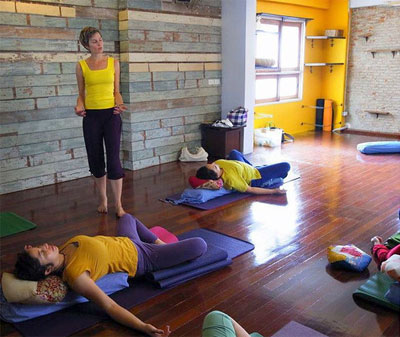
To help a troubled and suffering world, and shift from an environment in which volatility, uncertainty, complexity and ambiguity dominate, resulting in what seems to be and ever-increasing amount of fear, anxiety and depression, the Bodhisattva vows to become skillful in their ability to respond. They meet the volatility with a vision of the Buddhist path and a vow to become it; they meet the uncertainty with understanding and wisdom; they meet the overwhelming complexity with clarity and compassion; and they meet the debilitating ambiguity with agility and flexibility.
To develop these skillful qualities will be the great challenge and promise for today’s Bodhisattvas. It is notable, I think, that our growing cities, expanding technology, and an increased capacity to connect and communicate with each other have the potential to bring the Bodhisattva’s skills and qualities to many more people, and to amplify their positive impact. I believe that the Bodhisattva’s way of being and path of practice is essential to making a better future, and so I am dedicating the next two years of my life to teaching about the path of the Bodhisattva, embodying it, expressing it, and trying my best to make it accessible for people from all walks of life.
The single most powerful factor in determining whether our path is volatile or peaceful, uncertain or beneficial, self-centered or compassionate, is our motivation, or intention. We have found that the silent inward focus of meditation, the slow mindful movements of yoga, and the sharing of understanding that happens in group discussion are extremely helpful to explore and discover that which is motivating us at a deepest level. In our retreat at Tassajara we will practice yoga, meditation, group exercises and discussion to help us re-connect with ourselves and each other at a more intimate level, and start to reveal and articulate our deepest intentions as we explore the Bodhisattva path together.
As we actively engage with this notion of the Bodhisattva path and the intentions which inform and direct us on the path, we will gain access to new parts of ourselves, to deeper, more fundamental places of being, belonging and relating to the world. We will also find that our perception of our life and our closely held views and beliefs will shift, and that as we allow for a greater awareness in each moment, we will become ‘bigger,’ opening new potential for ourselves. We will see that coming from a place of intention our life comes alive with more meaning, and this meaning supports a greater intimacy with others, as we can meet people at a deeper, more fundamental level of being. Lastly, we will discover that living with the intention of the Bodhisattva asks us to make our life a form of creative expression; it requests us to engage creatively with the present moment, co-creating the next moment, and a better future for all beings.” — Robert Thomas


